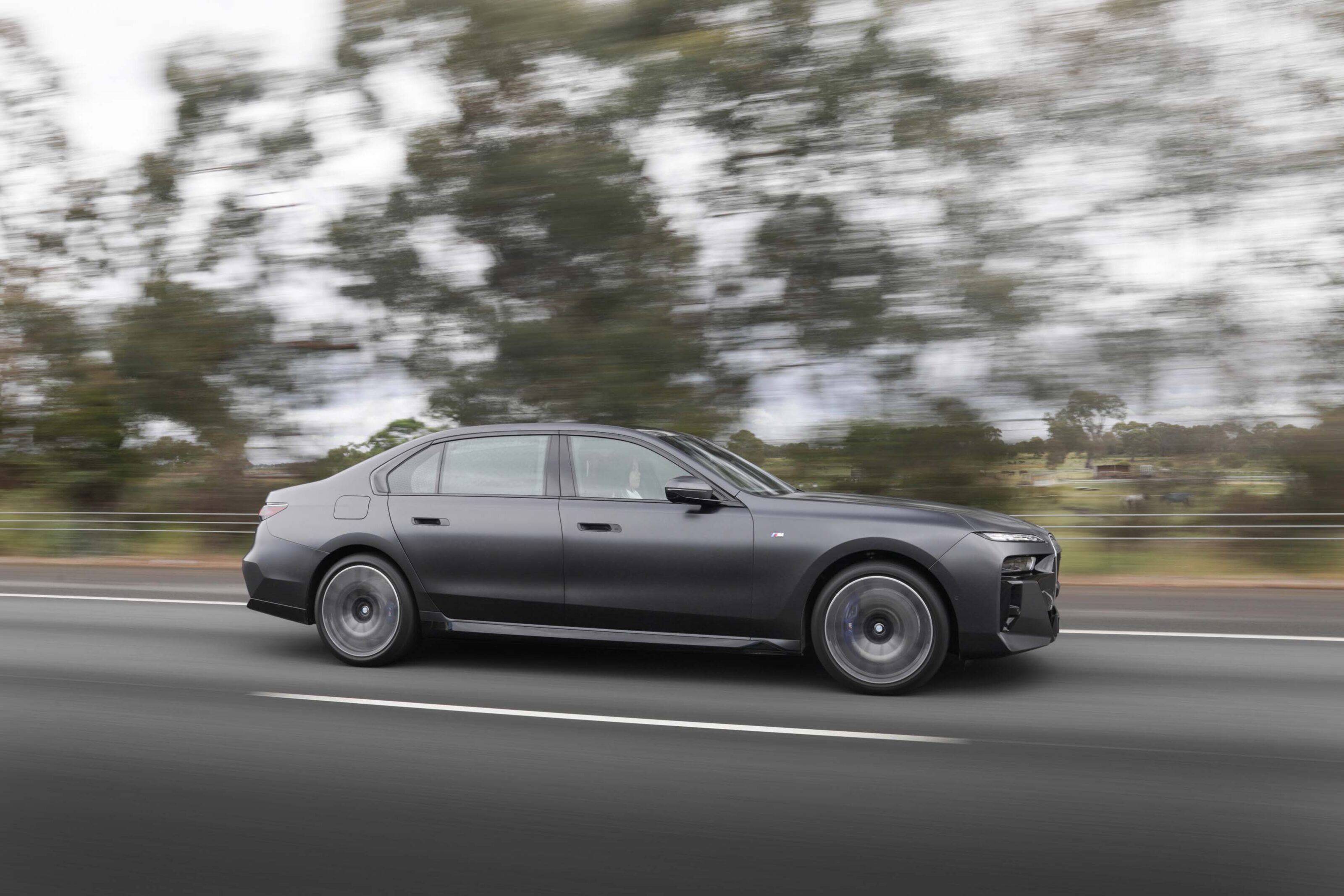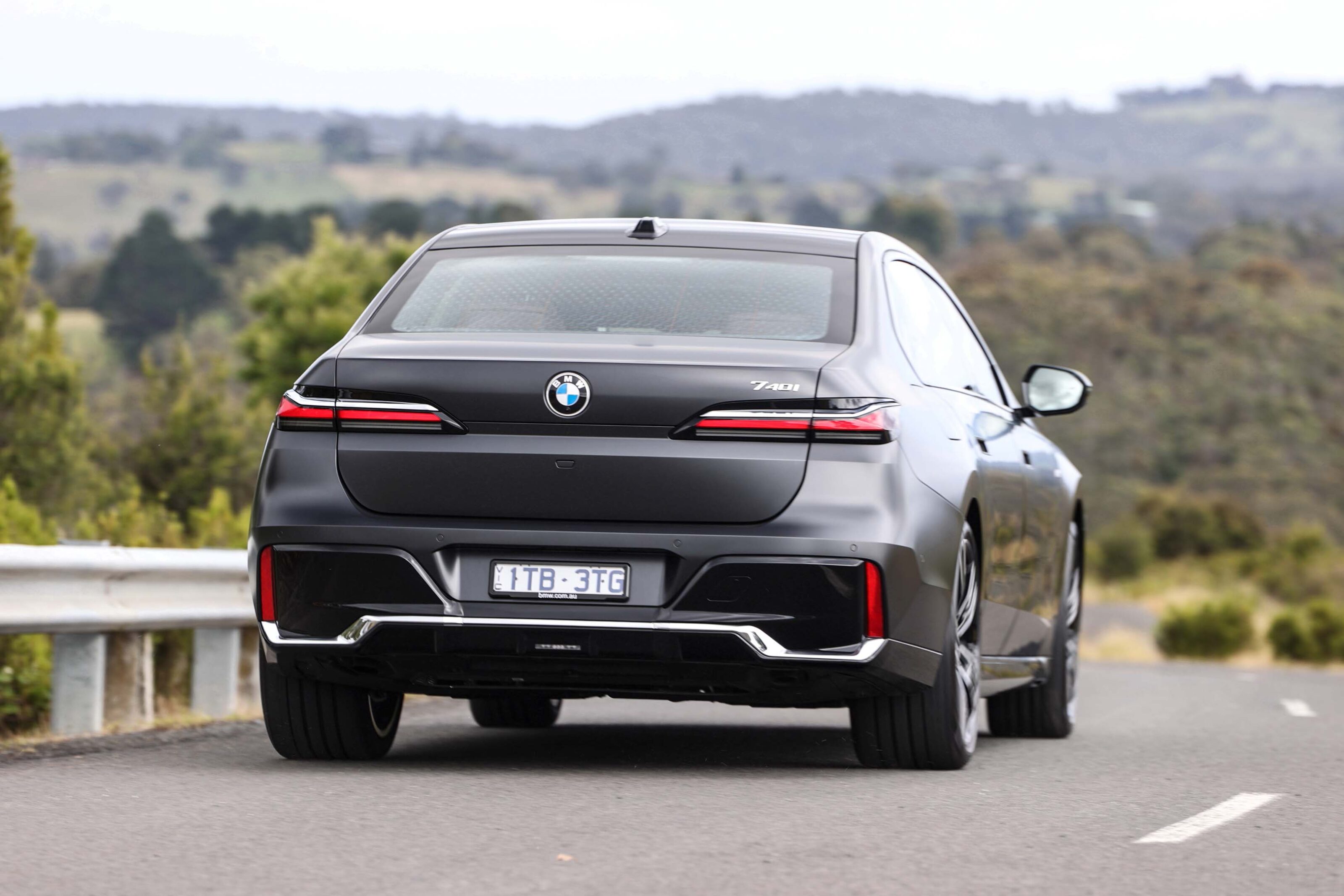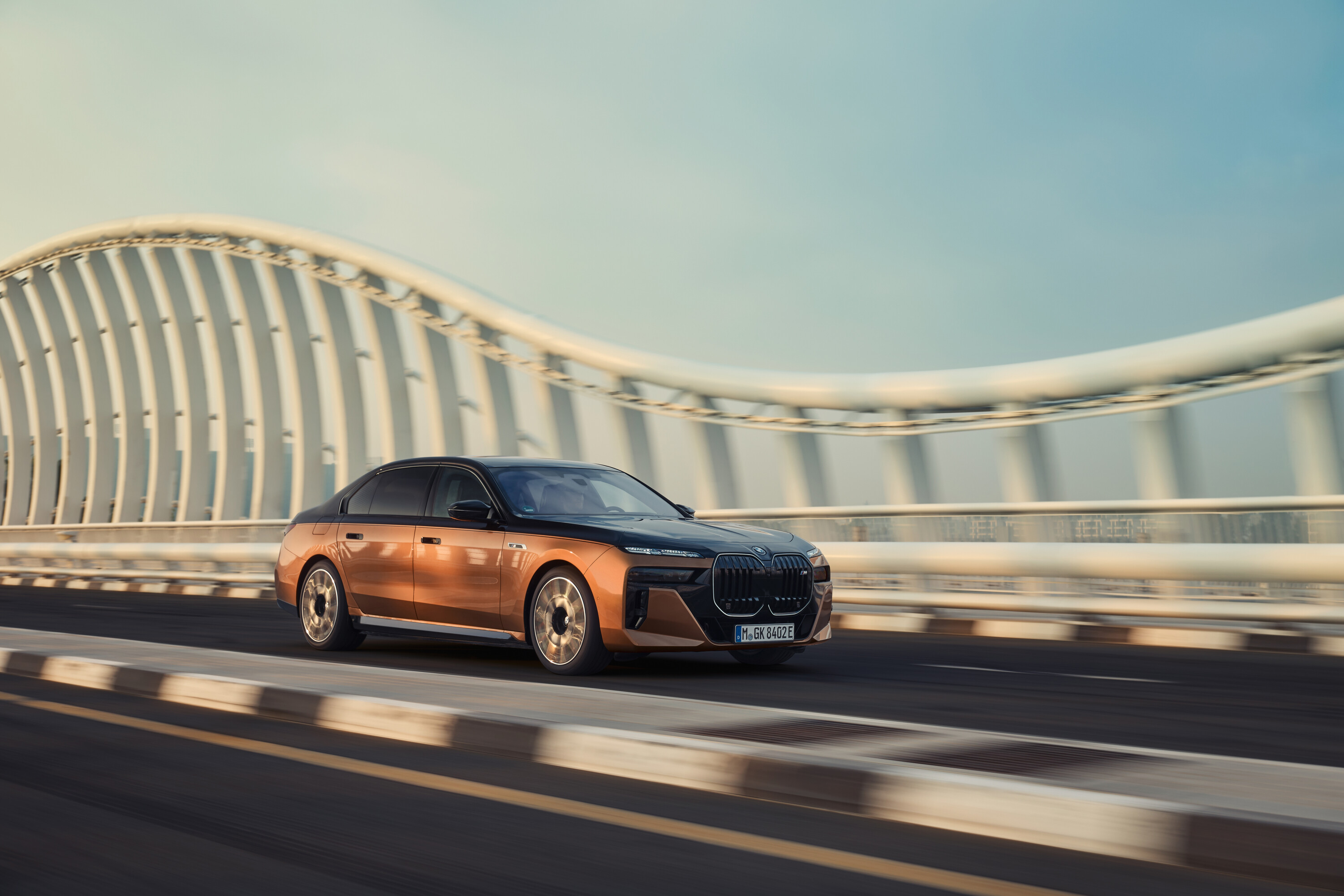Score breakdown
Things we like
- Imposing design
- Outstanding ride and refinement
- i7’s slick driveability and silky thrust
- Benchmark rear-seat experience
Not so much
- Dynamic talent not as accessible as a W223 S-Class’s
- Over-styled screen graphics
- Some control interfaces lack intuitiveness
- Rear styling lacks distinction
Almost a year after the W223-generation Mercedes-Benz S-Class wowed us with its all-round excellence and supreme elegance – prompting the label of ‘best sedan in the world’ – BMW has responded with an all-new seventh-generation (G70) 7 Series.
Simplified to just two variants for Australia – one petrol, one electric – the imposing new 7 Series has bucked convention and reimagined what a flagship sedan should be for BMW.
Not only is it the first truly modern 7 Series design since the Chris Bangle-penned E65 of 2001, animated by an intimidating front end, Munich’s statement sedan also rejects conservatism with its packaging – offering just one super-sized body style in all markets, rather than the short- and long-wheelbase variants of the past.

At almost 5.4m long, riding on a slightly longer wheelbase (3215mm) than the previous L version, the new 7 is easily the most imposing limousine in its segment. It also stands 65mm taller to make entry and egress more dignified, yet the new 7 is unashamedly flamboyant – almost to the point of brashness – in its individual expression of futuristic luxury.
Unlike Europe, Australia only gets a turbo-petrol-powered G70 – the rear-drive 740i – to accompany the range-topping i7 xDrive60, which commands a near-$30K premium but is expected to make up roughly 50 per cent of sales volume for the new 7 Series.
Based on our initial drive impressions, however, the star-billing i7 deserves even greater popularity because its execution is deeply impressive.

JUMP AHEAD
- How much is it, and what do you get?
- Interior comfort, space and storage
- What is it like to drive?
- VERDICT
How much is it, and what do you get?
At $268,900, the ‘standard wheelbase’ 740i is priced to compete with the S450 L ($268,491) in the petrol-powered limousine sector whereas the $297,900 electric i7 significantly undercuts its closest Mercedes-Benz rival – the electric EQS53 AMG ($328,400). All prices before on-road costs.
Unlike the clear-cut rivalry between 740i and S450 L, however, the i7 and EQS53 are quite different luxury cars. In terms of size, the EQS has an almost identical wheelbase length to the i7, and weighs the same (around 2640kg), but is significantly shorter in overall length (by 175mm).
And the electric EQS is differentiated from the combustion-engined S-Class in every possible way, whereas the i7 is almost identical to a 740i apart from badgework and a few minor details – giving BMW’s electric limousine some clear air in terms of intended audience.

Defining standard features of the Australian 740i include 20-inch M Sport alloy wheels, four-wheel steering, adaptive air suspension, BMW crystal headlights (with Swarovski crystal inlays), an illuminated kidney grille (not yet globally legislated but able to be ‘switched on’ when that happens in the coming months), a panoramic glass roof, M carbon-fibre interior trim, merino leather upholstery, multi-functional electric front seats with massaging, front and rear seat heating, 20-speaker Bowers & Wilkins audio, BMW Individual metallic paint and five years or 80,000km of free servicing.
The 740i also includes BMW’s Travel & Comfort system, Driving Assistant Professional and Parking Assistant Professional.

The i7 xDrive60 adds all-wheel drive, 21-inch M alloy wheels, Executive Drive Pro (with active anti-roll and active roll comfort suspension), automatic doors (acquired from Rolls-Royce), merino and cashmere-wool upholstery, multi-function rear seats, Executive Lounge rear console, 35-speaker Bowers & Wilkins diamond surround-sound audio, and an enormous 31.3-inch BMW theatre screen for rear-seat passengers that silently lowers itself from the headlining.
BMW also throws in a third-generation wallbox charger and five-year ChargeFox subscription. And if you’d prefer your new-gen 7 without the standard M Sport package, BMW offers the much shinier Design Pure Excellence appearance package on both models for a more traditional style.
Options include ‘frozen’ matte paint ($2600), two-tone metallic paint ($17,500) and the Connoisseur Lounge Package ($27,900 on 740i, $9000 on i7) that brings active rear-seat ventilation, rear massaging function and Executive Lounge console.

Interior comfort, space and storage
With its taller roofline and doors that open to almost 90 degrees – automatically in the i7’s case, in six different ways! – the new-gen 7 is clearly about introducing a degree of SUV elevation to the traditionally low-slung limousine form factor.
And once you’re inside its screen-dominated cabin, anyone familiar with the dull conservatism of the previous generation will be blown away by the new 7’s combination of technical prowess and design warmth.
The fact that there’s an enormous curved screen across more than half the dashboard – consisting of a 12.3-inch instrument display and a 14.9-inch centre control display – appears almost incidental because there are so many other interesting aspects to its interior design.
Classicists will much prefer the clean cohesion of an S-Class cabin, yet the brash new 7 somehow stops short of appearing completely garish, despite its focus on sparkly detailing and clashing patterns.

The tan leather and bright-pink ambient lighting of the first i7 we drove seemed to perfectly synergise with Elton John’s Australian tour, yet it also worked.
Even the dashboard’s hidden air outlets operate seamlessly, though some of the background screen graphics are borderline over-styled and the icons for the control screens on the rear doors look like they’re from a cheap Android phone. And while the intricate speaker grilles are styled to mimic a fabric pattern, they’re also quite sharp and can be unkind to misdirected fingernails.
Admittedly, the multitude of colour, trim and lighting options mean that you can suitably tone down the 7’s interior if you desire, though the fundamentals of its seating remain spot-on. The front buckets are everything you’d expect – broadly comfortable, yet impressively supportive – while the thatched seat upholstery, particularly the i7’s gorgeous leather and cashmere-wool combination, adds textural warmth to this unashamedly high-tech cabin.

Both the 20- and 35-speaker B&W audio systems are bangers, and the 31.3-inch rear-seat theatre screen (optional on 740i) is one of the finest examples of technological one-upmanship we can think of – the kind of tech you didn’t know you need until you have it.
Yet it’s the 7 Series’ outstanding rear-seat comfort and vision, combined with effortless access and available space, that confirms that this new-generation limousine sedan sits right at the top of its class for occupant pampering.
Apart from some detailing in the instrument display, the only tangible difference between 740i and i7 is boot space. The petrol-engined model relegates 540 litres to luggage duties whereas the electric sedan reduces that to 500 litres due to underfloor electric motor storage.

What is it like to drive?
Based on our launch drive, it’s hard to directly compare the dynamics of the G70 7 Series with the W223 S-Class because BMW chose the kind of roads that owners might encounter – namely, not too many corners – whereas Mercedes-Benz directed the new S down some of Victoria’s best driving roads.
With standard four-wheel steering (called ‘Integral Active’) and adaptive air suspension, the BMW combines a degree of pointability with an outstanding level of refined ride plushness that makes this huge sedan shrink around its driver while feeling expensive. Yet there’s ultimately no escaping the new 7’s sheer size, or the degree of aloofness from its steering, and on tight mountain roads the 2090kg 740i fails to transcend what the scales say.

Best Electric Cars, $65k-80k: Australia’s premium EVs tested
In part two of our three price-based EV buying guides, we compare Australia’s electric cars priced between $65,000 and $80,000
With its low-mounted powertrain and uprated suspension’s active anti-roll and active roll comfort properties (optional on 740i), the all-wheel drive i7 is superior at combining chassis poise and corner-exit drive with a cushy ride.
Indeed, given its 2640kg ballast, the i7 does a superb job of maintaining its cool, though in both new 7s we found the suspension’s Sport mode to be too firm and not in keeping with the flagship BMW’s station in life.

As for the drivetrains, the i7 combines a 106kWh battery with front and rear electric motors for a total of 400kW and 745Nm – enough for a claimed 0-100km/h sprint in 4.7sec, up to 625km of range, and a 10-80 per cent charging time of 34 minutes. Its combination of silken smoothness with instant throttle response and searing accelerative thrust is borderline addictive, managing to make the combustion-engined 740i feel comparatively grainy and a touch lethargic.
While BMW’s 0-100km/h claim for the 280kW/540Nm 740i is an impressive 5.4sec, and its maximum torque spread covers a vast area (1850-5000rpm), it simply can’t match the crisp immediacy of its electric sibling.
For all the 740i’s capabilities – impressive high-rev refinement, strong performance and surprising thrift from its 48-volt mild-hybrid, single-turbo 3.0-litre (combined consumption is 7.9L/100km) – the i7 is much more appealing from a driving perspective.

VERDICT
If you’ve already forgotten what the previous G11/G12 7 Series generation looked like (think overblown 5 Series), or the generation before that (the handsome but understated F01 7 Series), you’re not alone. But that will never happen with the G70 7 Series.
From its imposing shape to its muscular proportions and swathe of intriguing design details, this is a limousine that begs for attention. And it maintains that inside with almost youthful flair – embracing futurism with a degree of whimsy that so often eludes cars like this.
It may not possess the timeless elegance and refined taste of its chief Mercedes-Benz rival, but that gives the 7 Series scope to push a few boundaries and be a bit brash, yet with just enough restraint to keep it classy.

The new 7 doesn’t feel as dynamically suave as a W223 S-Class, though for its intended audience, the flagship BMW’s brilliant ride, outstanding refinement, benchmark space and seating comfort, and supreme drivetrain smoothness will be enough.
Yet of the two variants on offer, it’s the i7 that really shines. The silky immediacy of the i7’s movement makes the 740i feel and sound a bit dated, and even though the i7 weighs a shed-tonne, its lower centre of gravity and superb driveability make amends.
Add a worthwhile degree of extra equipment for its modest price premium – plus very cool (optional) two-tone black-over-grey paint (our colour choice) – and you can see why the i7 is the new Seven that makes the most sense.
SCORING
Score breakdown
Things we like
- Imposing design
- Outstanding ride and refinement
- i7’s slick driveability and silky thrust
- Benchmark rear-seat experience
Not so much
- Dynamic talent not as accessible as a W223 S-Class’s
- Over-styled screen graphics
- Some control interfaces lack intuitiveness
- Rear styling lacks distinction
We recommend
-
 News
News2024 BMW 7 Series and i7 Australian pricing and features
The newest iteration of BMW’s bleeding-edge limousine is here, starting from $268,900
-
 Reviews
Reviews2023 BMW i7 review: First prototype drive
Want new-age luxury and efficiency in an old-style wrapping? Enter BMW's all-electric i7 limo
-
 News
NewsBMW unveils 2024 i7 M70 at Auto Shanghai
The i7 M70 is BMW’s most powerful sedan ever – and it’s coming to Oz





